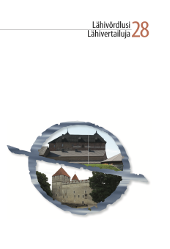Riigikeele oskusest, kasutamisest ja väärtustamisest Soome ja Eesti muukeelsete noorte näitel
The similarities and differences between young nonnative speakers’ skills, use and valuing of the official language in Finland and Estonia
Author(s): Birute Klaas-Lang, Kristiina PraakliSubject(s): Education, Language acquisition, Finno-Ugrian studies
Published by: Eesti Rakenduslingvistika Ühing (ERÜ)
Keywords: ofcial language profciency; attitudes; second language acquisition; Estonian; Finnish;
Summary/Abstract: In Finland, the average score of a non-native Finnish speaker on a B1-level Finnish test at the end of basic school is 87%, exceeding the 64.8% achieved in Estonia. In Estonia, the students’ insufficient Estonian skills and the structure of the linguistic environment limit the use of the official language. On the example of qualitative data, we aim to identify the similarities and differences between young non-native speakers’ skills, use and valuing of the official language in Finland and Estonia while placing the topic in the wider context of language learning. Te research is based on textual data from semi-structured group interviews which were analyzed and interpreted using content analysis. Te interviewees were 9th grade students of general education schools from Estonia and Finland. Eight 90-minute interviews in Russian with a total of 111 students were conducted in Russian-language basic schools in Estonia; in Finland, three interviews with a total duration of 135 minutes were conducted with 15 native Estonian-speaking 9th grade students from a basic school in the capital area. Observational data from fieldwork in Estonia and Finland (class observations, participant observations, conversations and interviews with teachers and school administration) was used as secondary data. Official language skills. Both countries’ students mostly evaluated their official language skills at the end of basic school as “good”. Te teachers agreed, with native official language speakers being more critical in both Finland and Estonia. Estonian youth see inadequate verbal skills as their greatest problem and the learning of language structure as less essential. Finnish youth consider the acquisition of grammatical structures most important and written language skills as their main problem area. Te “future self” of Finnish youth is located in Finland and the language is needed to continue education and work there. Estonian students’ insufficient speaking skills hinder communication right now. Since their “future self” was often placed outside of Estonia, improving writing skills in the official language as a basis for academic success was seen as less important. Official language use. Students in both countries mainly use the official language at school, in the official language class and subject classes. While in Estonia some students spoke only Russian at school outside of official language classes, the Finnish school provides more opportunities for “immersion” in subject classes and elsewhere. Similarities in the students’ interactions outside of school are numerous, including the existence of many native language communities that narrow the domain of official language use. Exceptionally, some students from the areas of Tartu and Tallinn confirmed daily use of Estonian also outside of school. Youth in both countries consume native-language media. In social media, English is used in addition to native and official languages. Russian-speaking students sometimes use English to interact with Estonians even in everyday interactions. Valuing of the official language. Students in both countries report pragmatic reasons for the need to learn the official language: to continue their education, get a good job, earn enough to live comfortably. However, there is a clear difference in the attitudes: since the Finnish youth’s “future self ” lives in Finland, achieving proficiency in the official language was considered self-evident. Finnish is valued and its sustainability is not in doubt. Estonian remains the language with which the students feel a connection. Estonian students also emphasize the need for proficiency in the official language but it is temporary and only needed for living in Estonia. A language with few speakers might not have sufficient (market) value and its sustainability is questioned.
Journal: Lähivőrdlusi. Lähivertailuja
- Issue Year: 2018
- Issue No: 28
- Page Range: 109-142
- Page Count: 34
- Language: Estonian

